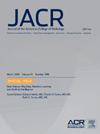Office-Based Diagnostic Imaging Interpreted by Nonphysician Practitioners: Characteristics, Recent Trends, and State Variation
IF 4
3区 医学
Q1 RADIOLOGY, NUCLEAR MEDICINE & MEDICAL IMAGING
引用次数: 0
Abstract
Purpose
Diagnostic imaging interpretations by nonphysician practitioners (NPPs) are increasing. With hospital-based imaging overwhelmingly interpreted by radiologists, we studied office-based interpretations by NPPs by their physician employer specialty.
Methods
Linking Medicare claims and provider datasets, we identified imaging interpretation claims submitted by nurse practitioners and physician assistants (together NPPs) in office settings, mapping NPPs to physician employer specialties, and assessed NPP characteristics and practice patterns.
Results
Between 2013 and 2022, the share of office-based imaging interpretations by NPPs increased 9.0% annually (from 2.52% to 5.47%) overall and by the following modalities: radiography (8.9%; 4.30%-9.23%), ultrasound (9.4%; 0.52%-1.18%), CT (9.4%; 0.13%-0.28%), MR (9.9%, 0.19%-0.44%), and nuclear medicine (7.2%; 0.07%-0.12%). Just 5.55% of NPPs rendered interpretations. NPPs employed by primary care physicians (PCPs) and orthopedists interpreted the largest shares of NPP imaging (39.5% and 34.1%, respectively). By modality, the largest shares by employer specialties were PCPs and orthopedists for radiography (39.7%, 37.4%), PCPs and practices without physicians for ultrasound (44.7%, 12.7%), PCPs and otolaryngologists for CT (58.2%, 17.1%), orthopedists and PCPs for MR (60.3%, 24.0%), and PCPs and cardiologists for nuclear medicine (40.4%, 25.9%). Younger NPPs (<35 years) interpreted imaging more frequently than older counterparts (≥65) (odds ratio 1.42 [95% confidence interval: 1.37-1.48]) and male NPPs interpreted imaging more frequently than female NPPs (odds ratio 1.61 [95% confidence interval: 1.58-1.63]). Overall interpretation shares ranged from 13.16% in Alaska to 0.29% in Washington, DC.
Conclusion
In Medicare, the share of office-based imaging interpretations performed by NPPs is increasing, varying considerably by state. Interpretations are performed by relatively few NPPs, particularly those younger, male, and employed by PCPs and orthopedists.
由非执业医师解读的诊室诊断成像:特征、最新趋势和各州差异。
目的:非医师执业者(NPPs)对诊断成像的解释越来越多。由于医院的影像诊断绝大多数由放射科医生负责,我们按医生雇主的专业对非医师从业人员在办公室进行的影像诊断进行了研究:我们将医疗保险报销单和医疗服务提供者数据集联系起来,确定了执业护士和医生助理(合称 NPPs)在诊室环境中提交的影像解读报销单,将 NPPs 与医生雇主专业进行了映射,并评估了 NPP 的特征和执业模式:从 2013 年到 2022 年,NPP 在诊室成像诊断中所占的比例每年增长 9.0%(从 2.52% 增长到 5.47%),总体而言,NPP 在以下医学模式中所占的比例每年增长 9.0%:放射(8.9%;4.30%-9.23%)、超声(9.4%;0.52%-1.18%)、CT(9.4%;0.13%-0.28%)、磁共振(9.9%,0.19%-0.44%)和核医学(7.2%;0.07%-0.12%)。仅有 5.55% 的 NPP 提供解释。初级保健医生 (PCP) 和矫形外科医生聘用的 NPP 在 NPP 成像中提供解释的比例最大(分别为 39.5% 和 34.1%)。按方式划分,雇主专科所占比例最大的是初级保健医生和骨科医生负责放射摄影(39.7%,37.4%),初级保健医生和无医生诊所负责超声波(44.7%,12.7%),初级保健医生和耳鼻喉科医生负责 CT(58.2%,17.1%),骨科医生和初级保健医生负责 MR(60.3%,24.0%),初级保健医生和心脏病医生负责核医学(40.4%,25.9%)。较年轻的国家医疗计划人员(结论:在医疗保险中,诊室医疗所占比例较低:在医疗保险中,由非专业医师进行诊室成像解释的比例正在增加,各州之间差异很大。进行判读的 NPP 相对较少,尤其是那些年轻、男性、受雇于初级保健医生和骨科医生的 NPP。
本文章由计算机程序翻译,如有差异,请以英文原文为准。
求助全文
约1分钟内获得全文
求助全文
来源期刊

Journal of the American College of Radiology
RADIOLOGY, NUCLEAR MEDICINE & MEDICAL IMAGING-
CiteScore
6.30
自引率
8.90%
发文量
312
审稿时长
34 days
期刊介绍:
The official journal of the American College of Radiology, JACR informs its readers of timely, pertinent, and important topics affecting the practice of diagnostic radiologists, interventional radiologists, medical physicists, and radiation oncologists. In so doing, JACR improves their practices and helps optimize their role in the health care system. By providing a forum for informative, well-written articles on health policy, clinical practice, practice management, data science, and education, JACR engages readers in a dialogue that ultimately benefits patient care.
 求助内容:
求助内容: 应助结果提醒方式:
应助结果提醒方式:


